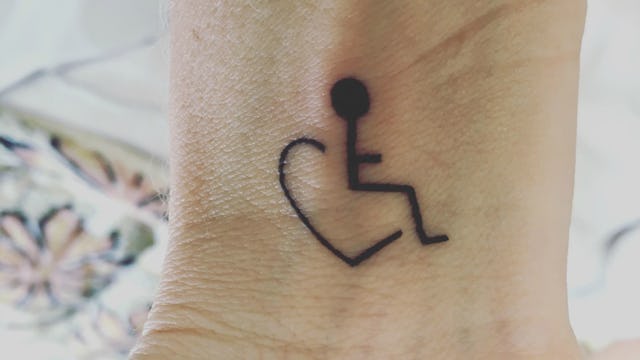What This Tattoo Means For My Son With Cerebral Palsy

I live in the suburbs of Tennessee. I drive a minivan. Most of my clothes are from Target and/or Anthropologie flash sales. I have three children and applesauce squeeze pouches in my purse. I am not the typical tattoo client. But I’d been thinking about it for a while, Googling pictures, and texting close-up shots of ambiguous body parts to my husband at work.
And then finally, on a trip to Los Angeles for a writer’s conference, I decided to go for it. It was perhaps the nerdiest tattoo session ever to happen on Sunset Boulevard. I called ahead and came in with a picture. And then during the actual inking, the tattooist and I talked books. Because this is how I make small talk: “So what are you reading?”
We complained about the discrepancies in the movie version of Ready Player One, which led us down a rabbit hole of ’80s film references. When it was done, I stood in the mirror and held out my wrist. “You think Charlie will like it?” he asked.
“He’ll love it,” I said.
Charlie is my son. He’s six and has cerebral palsy. He uses a wheelchair to get around and a speaking device to talk. When I flew home the next day and showed him the tattoo, he understood instantly that it was for him, because though he is mostly nonverbal, he’s as smart as they come. The tattoo is an outline, in black, of the standard handicap sign that you see on everything—parking spaces, restroom doors, theater seats.
But instead of a wheel, it has a heart. I watched Charlie touch the heart, and then himself, and grin. I said, “How much does Mommy love you, bud?” and he touched my wrist again. Now, when I pick him up for school or lay him on the floor at night to change his clothes, the first thing he does is reach for my wrist. It is our point of contact and an unspoken reassurance that we are in this thing together.
It is so much more than a tattoo. It is a symbol for my kid who speaks in symbols. There’s a reason I did not get his initials or a more artistic rendering of him in his chair. I wanted it to be instantly recognizable—to him and anybody else who wants to know his story. It’s also a reminder to both myself and the world at large that a wheelchair doesn’t have to be a sad thing. People see a six-year-old kid in a wheelchair and their first instinct is to either look away or give an Eeyore smile. But walking or rolling—it’s just a way to get where you need to go and the getting there is the most important part. We love our wheels.
I am always intrigued by the stories tattoos tell. I love that each picture is an effort in ink to capture something ethereal—the way you feel about a person or place or a motto you want to heed. But most importantly, I love that my tattoo will remind my son that I am proud of his life and his abilities and the joy he sparks in others by simply being himself.
This article was originally published on